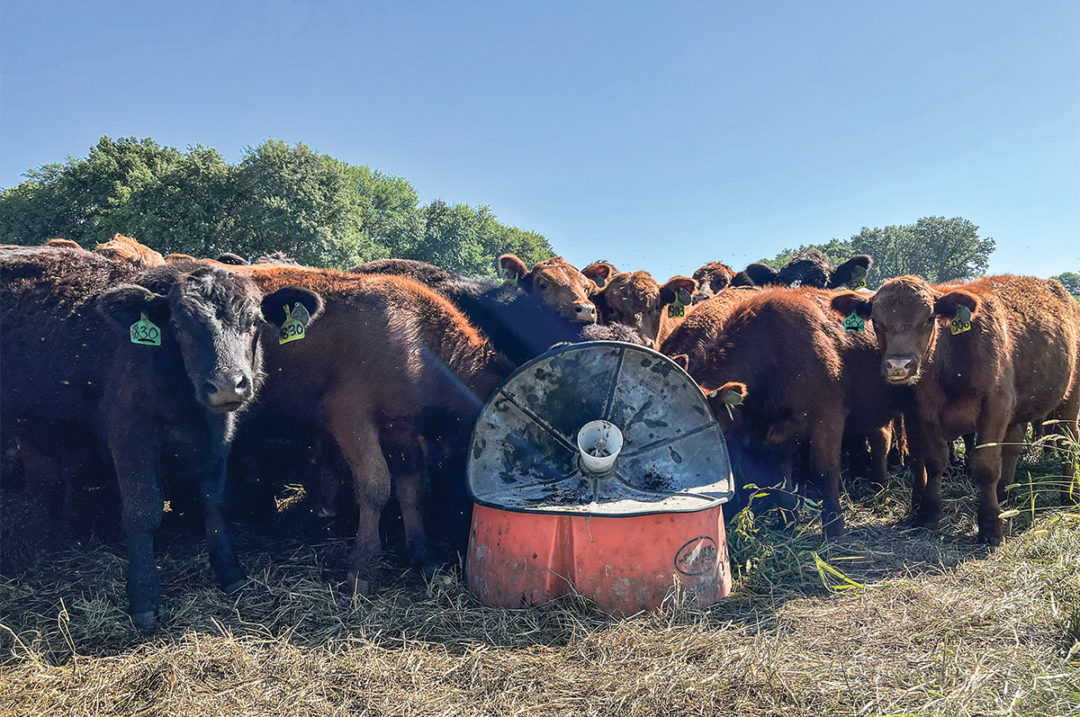Within a vitamin and mineral pack, there are different classes that are supplemented to cattle: macrominerals, trace minerals, vitamins, feed additives (yeast, enzymes, etc.), ionophores and Veterinary Feed Directive medications. While each class has their own nuances, I will just focus on trace minerals for this article.
There are 10 trace minerals, or microminerals, that are known to be required by beef cattle. However, in a trace mineral supplement, there are typically only seven included: cobalt, copper, iodine, iron, manganese, selenium and zinc. Ones that are not typically supplemented but are known to be required are chromium, molybdenum and nickel. All are elements inherently found in the environment, so why do they need to be supplemented?
Throughout the year, shifts occur in the abundance of minerals found in forages, which makes it difficult to maintain the levels required by individual animals. Additionally, cattle requirements will change throughout the year due to stages of production.
The requirements for cattle are dependent upon physiological status, gender, breed, the presence of antagonisms in the environment, presence of stress and the duration for which the cattle have been receiving the supplement. What benefits do trace minerals have on the health of cattle? Copper, selenium, zinc and manganese all support the immune system. Zinc also assists in proper hoof health growth and hardness, hormonal signaling, and RNA and DNA synthesis. Manganese supports fetal growth, while cobalt is required for vitamin B12 synthesis and aids in reproduction. Finally, iodine is used for thyroid hormone production. While these are broad categories, all trace minerals have an impact on the overall production status of cattle.
The most rewarding but stressful times on a cow-calf operation are calving and breeding season. Whether you calve in the spring, fall or somewhere in-between, the top priority is calving out healthy calves, with minimal complications, and rebreeding the cows for another season. The fundamental trace mineral requirements for cows during calving and breeding don’t change; however, their nutrient requirements will change, as will their dry matter intake. If you are feeding a mineral with a mixture of other feeds, be sure to watch dry matter intake to ensure each cow is getting enough of each trace mineral.
When cows don't get pregnant, your operation can lose $700 to $1,100 per cow per year depending on operating costs. The higher the operating costs, the higher your economic loss for next year. There will be some cows that do not get bred back; however, an easy investment into lowering the number of open cows is to provide accurate and sufficient trace mineral supplementation.
Clearly, trace mineral supplementation is an important investment for your beef herd. The type of trace mineral you use is also important.
-
Make sure the supplements you are evaluating are compared on equal footing. To do this, look at the expected feeding rate on the different feed tags. Make sure the mineral levels listed under the guaranteed analysis are at the same consumption level across the various products you are comparing and considering. For example, if one feed tag says to feed at 0.5 pound per head per day, this is not the same feeding rate as 2 ounces per head per day. After you decide on a supplement, be sure your cattle are consuming the mineral provided at the expected rate.
-
Know what the requirements are for your herd. This will take a conversation with your nutritionist, but have an idea of the status of your herd. What is the physiological status of your cows? If they are being supplemented with other feed sources, how much are they eating? What is the water quality?
-
Consider the most effective way of feeding mineral to your cattle. Can you use a mineral that is mixed into a grain mix, pellet, a free-choice mineral or do you need to use tubs? Are you currently feeding a certain way because that is what you have always done or because it is the best for your herd?
-
What is your budget? There are more bioavailable minerals that can be used to improve the mineral status of your cows if you are trying to overcome something, such as poor water quality or herd performance and health issues. Your nutritionist can help you weigh the pros and cons of different mineral sources.
- Finally, how are you storing the supplement? Make sure to store mineral in a dry, cool environment that is away from direct sunlight. A good rule of thumb is to only purchase a two- to three-month supply and be sure to rotate the supplement using the oldest product first.
Trace mineral supplementation is a worthy investment that will help the current and future status of your herd. However, take a front seat on the investment. Work with your nutritionist and be proactive in the investment you are making toward the future.
references omitted but are available upon request. Click here to email an editor.








